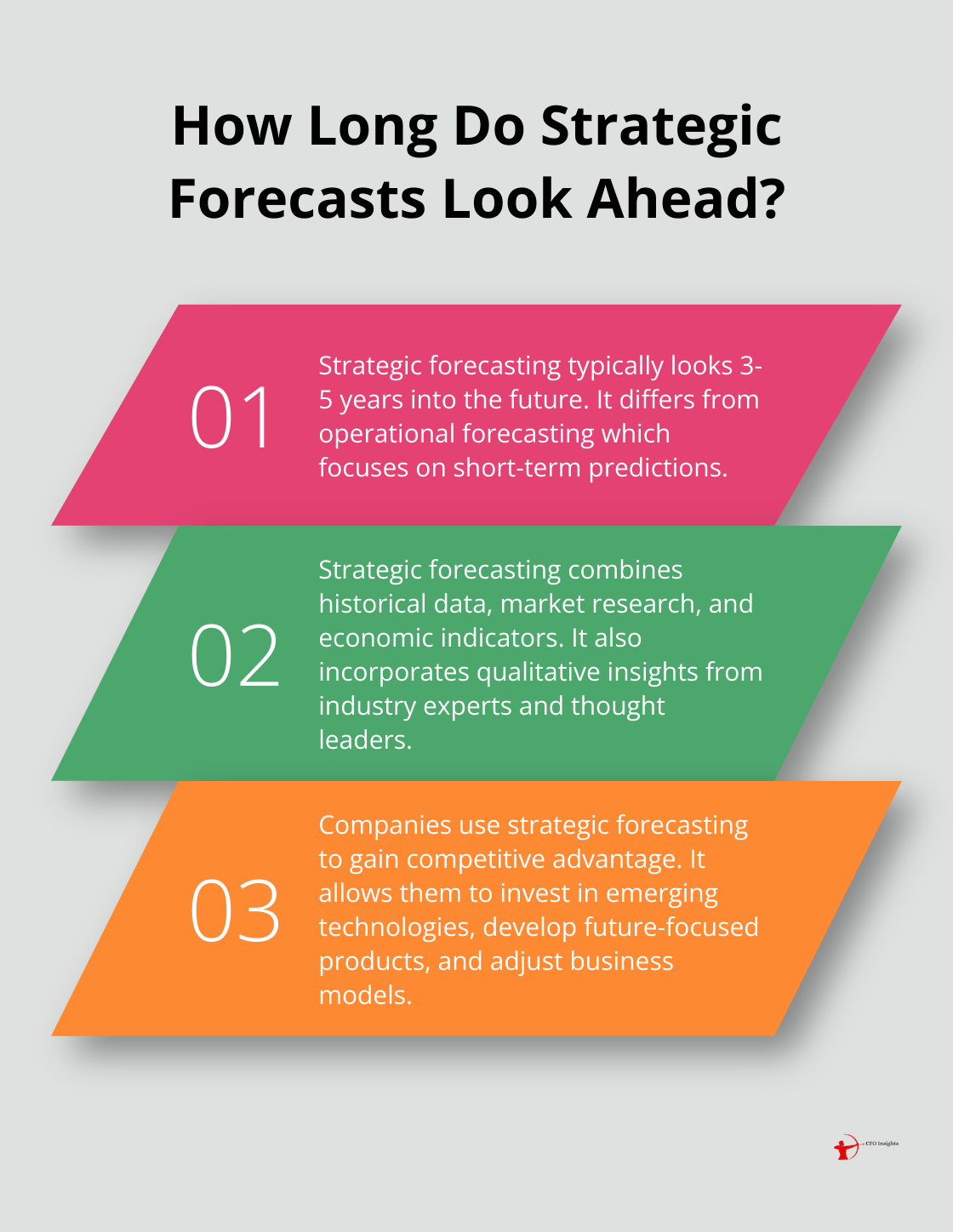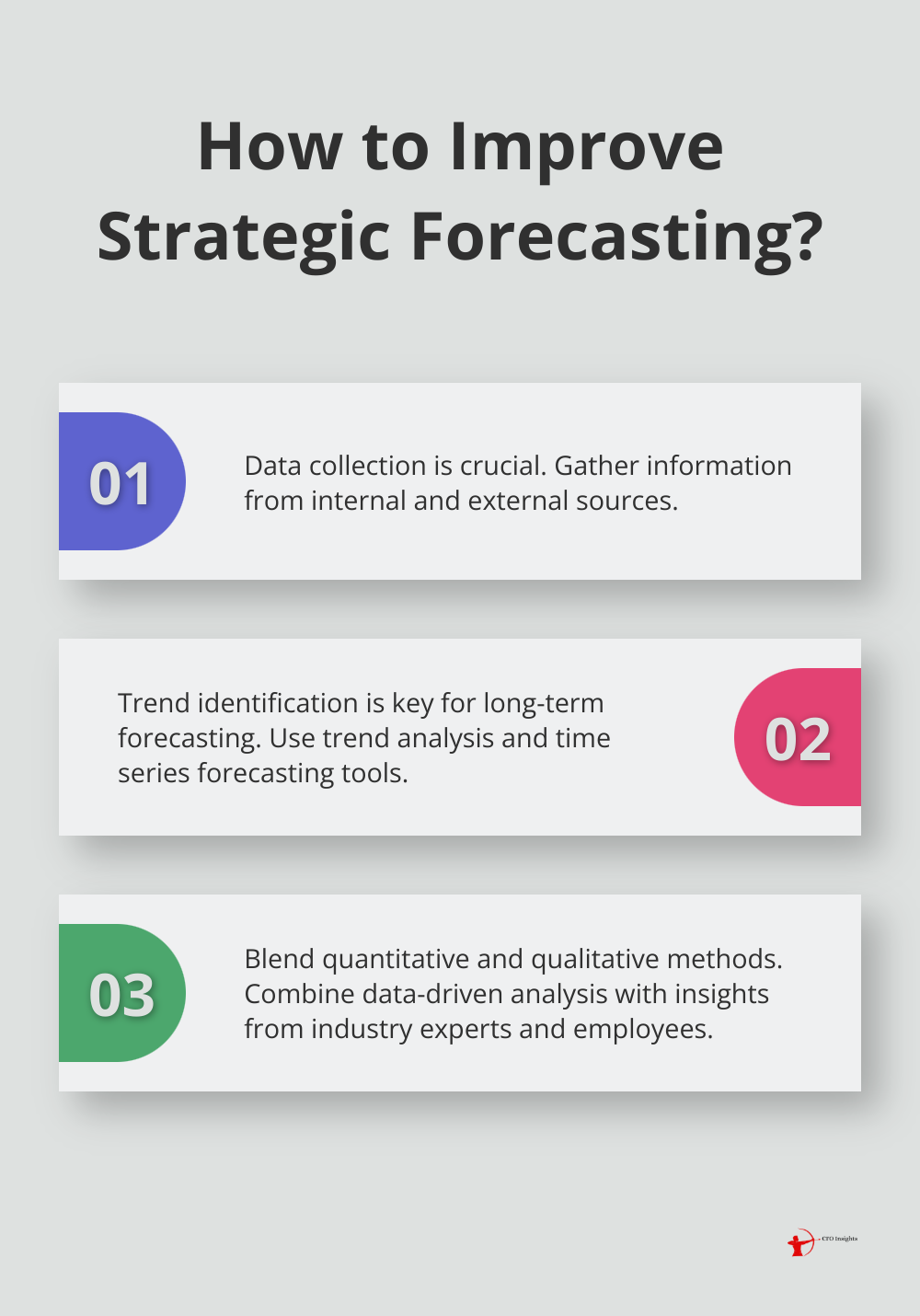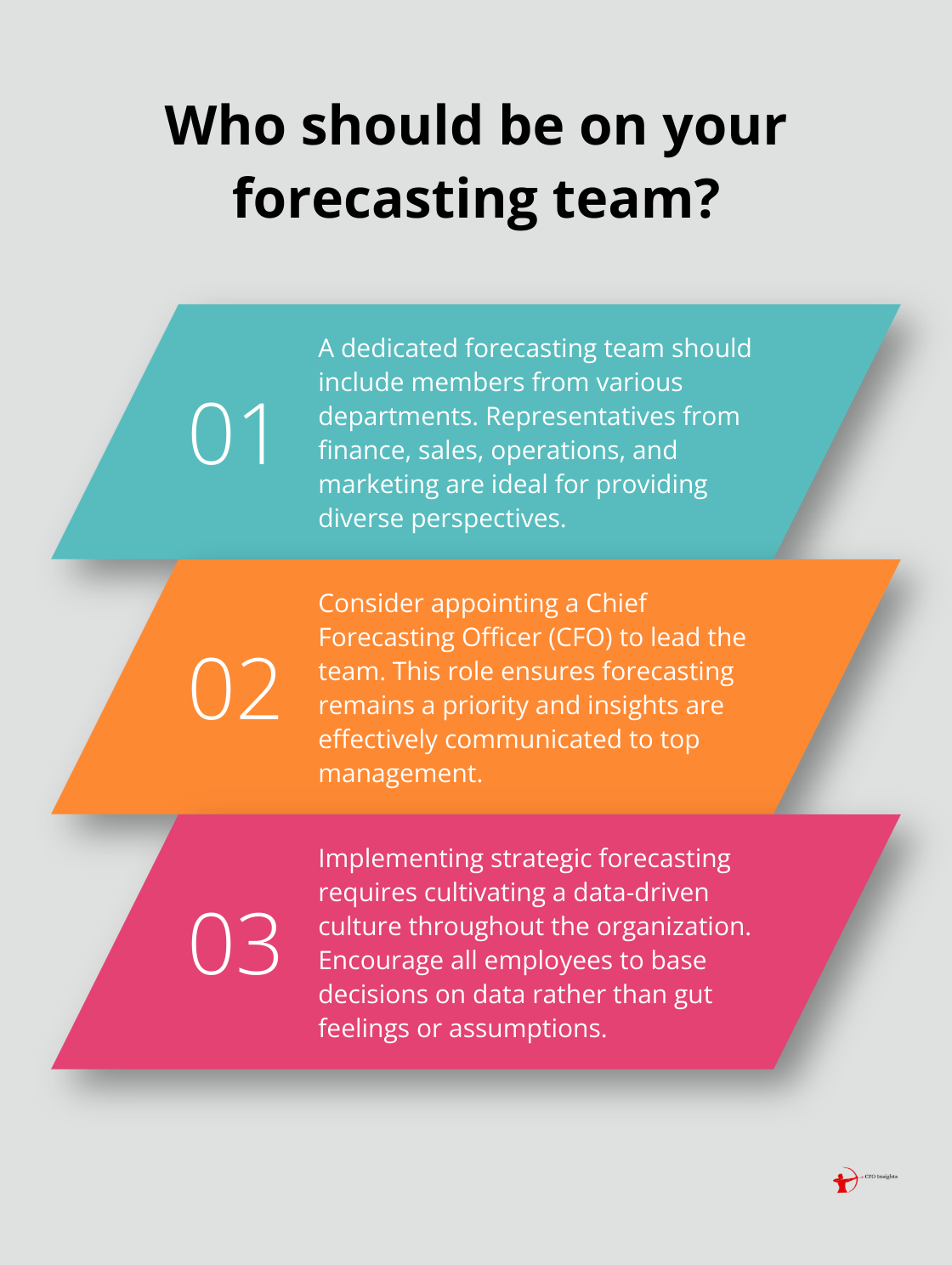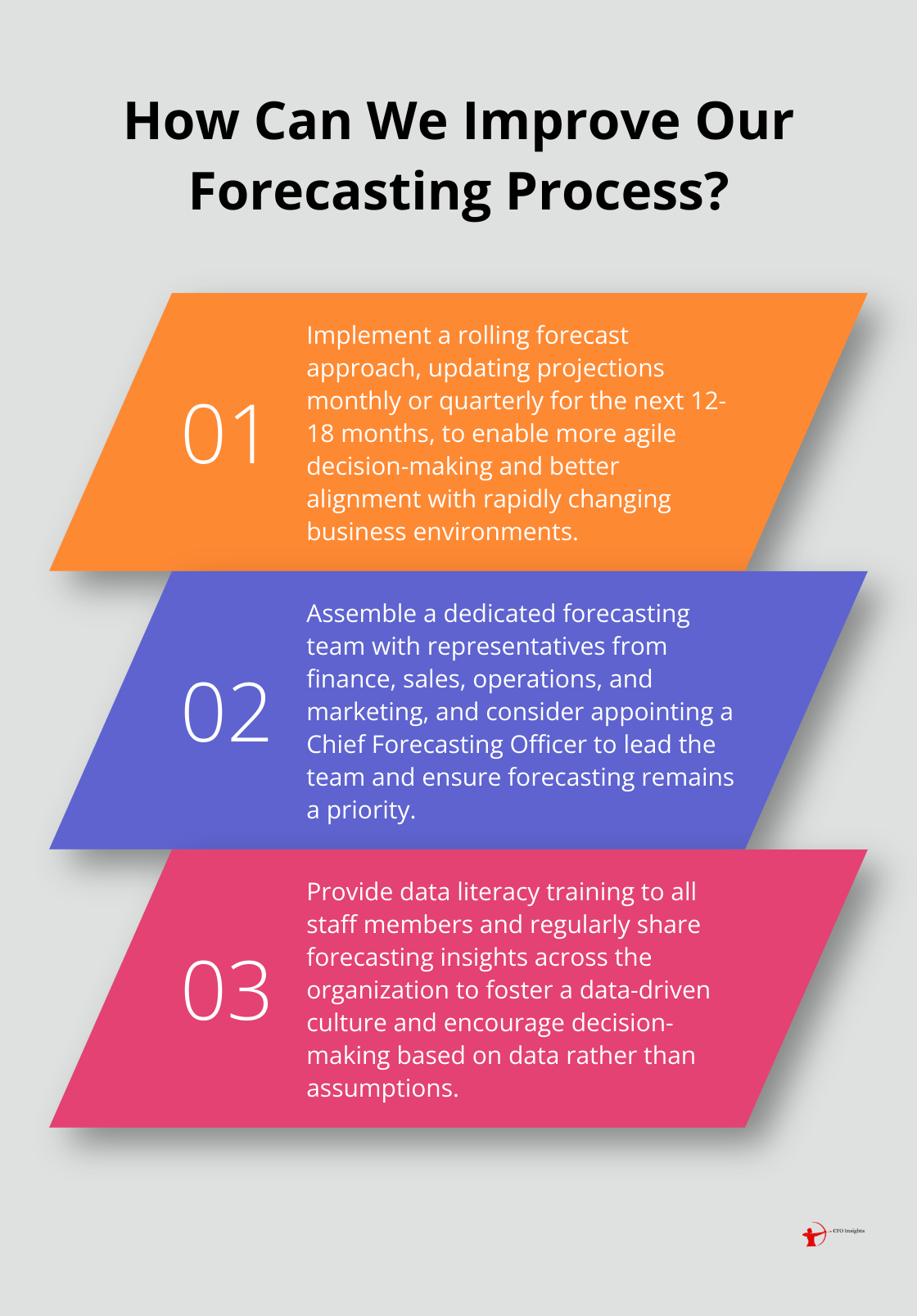Strategic forecasting is a game-changer for businesses aiming for long-term success. At CFO Insights, we’ve seen how this powerful tool can transform decision-making and drive competitive advantage.
In this post, we’ll explore the key components of effective strategic forecasting and provide practical steps to implement it in your organization. Get ready to unlock the potential of data-driven predictions for your business’s future.
What Is Strategic Forecasting?
The Essence of Long-Term Vision
Strategic forecasting is a powerful tool that helps businesses predict future trends and make informed decisions. It looks beyond short-term fluctuations to identify long-term patterns that will shape industries.

Strategic forecasting differs significantly from operational forecasting. While operational forecasting focuses on day-to-day or month-to-month predictions, strategic forecasting takes a broader view. It typically looks 3-5 years into the future (sometimes even further). This long-term perspective allows companies to anticipate major shifts in their market and position themselves accordingly.
Data-Driven Decision Making
Financial forecasting is predicting a company’s financial future by examining historical performance data, such as revenue, cash flow, expenses, or sales. It combines historical data, market research, and economic indicators to create a comprehensive picture of future trends. However, it’s not just about crunching numbers. The best strategic forecasts also incorporate qualitative insights from industry experts and thought leaders.
Some companies are using automation, machine learning, and advanced analytics to make the crystal ball clearer. This underscores the importance of investing in robust data analysis capabilities.
Competitive Advantage Through Foresight
Strategic forecasting can provide a significant competitive advantage. Companies that anticipate future trends can:
- Invest in emerging technologies before their competitors
- Develop products that meet future customer needs
- Adjust their business models to align with changing market conditions
Amazon’s early investment in cloud computing exemplifies this. Their strategic forecast of the growing demand for cloud services led to the creation of Amazon Web Services, now a major revenue driver for the company.
Real-World Impact
Netflix fundamentally changed how people consumed content by introducing DVD-by-mail and later pioneering streaming, adapting to digital innovation and putting themselves at the forefront of the industry.
In the manufacturing sector, companies use strategic forecasting to predict shifts towards sustainable materials. This insight allows them to retool production lines ahead of the curve, securing lucrative contracts with environmentally conscious customers.
Strategic forecasting doesn’t aim to predict the future with 100% accuracy. Instead, it prepares organizations for multiple potential futures, ensuring they’re ready to adapt and thrive no matter what comes their way. As we move forward, let’s explore the essential components that make strategic forecasting truly effective.
What Makes Strategic Forecasting Effective?
Robust Data Collection and Analysis
The foundation of any effective strategic forecast is high-quality data. This involves gathering information from a wide range of sources, both internal and external. Internal data might include sales figures, customer feedback, and operational metrics. External data could encompass market research reports, economic indicators, and competitor analysis.

Data collection is just the first step. The real value comes from analysis. Advanced analytics techniques can uncover hidden patterns and correlations that humans might miss, helping businesses develop more effective strategies.
Trend Identification and Scenario Planning
Identifying trends is essential for long-term forecasting. This involves looking beyond short-term fluctuations to spot underlying patterns that could shape the future of your industry. Tools like trend analysis and time series forecasting can be invaluable here.
Once trends are identified, scenario planning comes into play. This involves creating multiple potential future scenarios based on different assumptions, ensuring your business is ready for unforeseen events. This allows companies to prepare for various outcomes and adapt quickly as the future unfolds.
Blending Quantitative and Qualitative Methods
While data-driven analysis is important, it’s not the whole picture. Qualitative insights from industry experts, thought leaders, and even frontline employees can provide context and nuance that numbers alone can’t capture.
A balanced approach might involve using quantitative methods to identify trends and potential scenarios, then gathering qualitative input to assess their likelihood and potential impact. This combination can lead to more robust and nuanced forecasts.
Incorporating External Factors
No business operates in a vacuum. External factors like economic conditions, regulatory changes, and technological advancements can have a massive impact on a company’s future. Effective strategic forecasting must account for these factors.
One way to do this is through environmental scanning, which involves systematically surveying and interpreting relevant data about external influences. This process can help in SWOT analysis, resource allocation, and long-term planning, contributing to the survival and growth of the business.
The next section will explore how to implement these practices in your organization, ensuring that your strategic forecasting efforts yield tangible results and drive long-term success.
How to Implement Strategic Forecasting
Build Your Forecasting Dream Team
The first step is to assemble a dedicated forecasting team. This team should include members from various departments to provide diverse perspectives. Ideally, you’ll want representatives from finance, sales, operations, and marketing. Each brings unique insights that contribute to a more comprehensive forecast.

Consider appointing a Chief Forecasting Officer (CFO) to lead this team. This role ensures that forecasting remains a priority and that insights are effectively communicated to top management.
Leverage Advanced Tools and Technologies
Choosing the right tools is essential for effective forecasting. While Excel spreadsheets might suffice for basic projections, more sophisticated software can significantly enhance your forecasting capabilities.
We recommend exploring AI-powered forecasting tools that can process vast amounts of data and identify complex patterns. AI-based tools can help with various aspects of business planning and forecasting.
Cloud-based platforms offer real-time collaboration features, making it easier for your team to work together on forecasts. These tools also provide scenario modeling capabilities, allowing you to quickly adjust projections based on changing conditions.
Foster a Data-Driven Culture
Implementing strategic forecasting isn’t just about tools and teams-it’s about cultivating a data-driven culture throughout your organization. This means encouraging all employees to base decisions on data rather than gut feelings or assumptions.
Start by providing data literacy training to all staff members. Data literacy will drive success, and the more data literate your organization becomes, the better results you will have.
Regularly share forecasting insights across the organization. This transparency helps everyone understand the rationale behind strategic decisions and fosters buy-in for data-driven initiatives.
Continuous Refinement and Adaptation
Strategic forecasting is not a one-time event but an ongoing process. Your models should undergo continuous refinement and updates based on new data and changing market conditions.
Implement a regular review cycle, perhaps quarterly, to assess the accuracy of your forecasts and identify areas for improvement. Pay close attention to instances where your projections were off-target-these are valuable learning opportunities.
Try implementing a rolling forecast approach. Unlike traditional annual forecasts, rolling forecasts undergo updates on a regular basis (often monthly or quarterly) and always project a set time into the future (typically 12-18 months). This approach allows for more agile decision-making and better alignment with rapidly changing business environments.
Final Thoughts
Strategic forecasting transforms businesses for long-term success. Companies identify long-term patterns to make informed decisions that drive competitive advantage. This powerful tool helps anticipate market shifts and develop products that meet future customer needs.

Organizations face challenges with data quality, change resistance, and balancing quantitative and qualitative insights. Overcoming these obstacles requires commitment, resources, and a data-driven culture. Advanced tools and technologies process vast amounts of data to identify complex patterns.
CFO Insights has witnessed how effective strategic forecasting drives business growth. Our experienced professionals can help implement best practices in financial management and support your forecasting efforts. Visit our website to learn how we can tailor our fractional CFO services to your unique needs.




